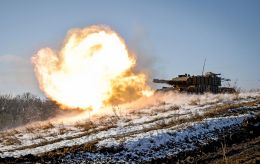Russia boosts production of UMPB-5R and Grom-1E: How many are planned
 Russia increases production of Grom-1E and UMPB-5R guided bombs (photo: Russian media)
Russia increases production of Grom-1E and UMPB-5R guided bombs (photo: Russian media)
Russia's defense industry plans to produce approximately 250 Grom-1E missiles and up to 500 UMPB-5R glide bombs by the end of the year, according to a report by RBC-Ukraine.
"One source in the Ukrainian Defense Forces explains that the Russians are currently working on increasing the range of these bombs, for example, by adding more fuel and reducing the amount of explosives," the report states.
According to RBC-Ukraine, by the end of this year, Russia aims to produce around 250 Grom-1E units and approximately 500 UMPB-5R units. However, these volumes may increase in the future.
Fight against glide bombs
Defense Express military expert Ivan Kyrychevskyi emphasized that even long-range glide bombs can be countered with the existing air defense systems.
"And given that, according to the Ukrainian Air Force, 2 of the 3 such bombs were hit in the Odesa region, this means that the target is subsonic and can be dealt with. But to say that Russian jet-powered KABs will now start falling on Kyiv and we can't do anything about it — objectively speaking, that is not the case at the moment," Kyrychevskyi noted.
How jet-powered glide bombs work
Russia began increasing the use of guided aerial bombs on the frontline at the end of 2023. They are based on Soviet high-explosive bombs, such as the FAB-250 and FAB-500, which were fitted with a universal glide and flight correction module (UMPK). These bombs are typically launched from Su-34 fighter-bombers.
During September and October, Russia developed and has now moved to final combat testing of bombs with new control modules. These modules provide a range, or combat radius, of around 200 km.
By adding a jet engine, the new glide bombs have become more similar to a small cruise missile and have gained an increased range, now extending to 80 kilometers, as previously recorded. With a range of up to 200 kilometers, the carrier aircraft does not need to approach the area covered by Ukrainian air defense.
The first strikes using these new bombs have already been recorded, including in Dnipro, Poltava region, and Odesa region – relatively rear areas of Ukraine. So far, there have only been isolated cases of the use of these new jet-powered aerial bombs. However, according to military intelligence, Russia is already moving to serial production of this weapon.
In the information space, different names for this bomb can be found. Sometimes they are called Grom-1E – this is another type of hybrid weapon that the enemy has occasionally used against Ukraine since early 2023. But the recent attacks in the Poltava and Odesa regions were most likely carried out with jet-powered glide bombs called UMPB-5R – bombs equipped with a jet engine.
On October 24, Russian forces used modified UMPB-5 jet-powered guided aerial bombs for the first time in the Odesa region.
On October 18, for the first time during the war, Russia struck the city of Lozova in the Kharkiv region with a jet-powered glide bomb. It is known that the bomb flew 130 km.

